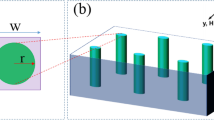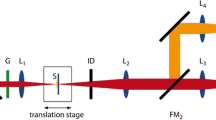Abstract
Periodic arrays of gold wires and split ring resonators (SRR) with a minimum feature size of 50 nm are fabricated on low-doped silicon. To our knowledge, the periodic arrangement of SRRs and wires considered in this work has not been studied in the near-infrared domain yet. For normal-incidence conditions, this metamaterial structure exhibits resonances at 70 and 170 THz (i.e., at λ ≈ 4.3 and 1.75 μm), which are identified as LC- and Mie resonances, respectively. These resonances are also observed for the SRRs alone, but the amplitude of the Mie resonance is reinforced due to the coupling between the SRRs and wires. The structure is simulated using finite-element software, while transmission and reflection measurements are performed with a Fourier transform infrared spectrometer. Numerical simulations are found to be in very good agreement with experimental characterizations, thereby showing that the Drude model used in calculations is well suited to simulate gold structures at near-infrared frequencies. Theoretical calculations predict that the metamaterial has a negative permittivity and a negative permeability near each resonance.
Similar content being viewed by others
References
Enkrich C., Wegener M., Linden S., Burger S., Zschiedrich L., Schmidt F., Zhou J.F., Koschny Th. and Soukoulis C.M. (2005). Magnetic metamaterials at telecommunication and visible frequencies. Phys. Rev. Lett. 95: 203901–4
Grigorenko A.N., Geim K., Gleeson H.F., Zhang Y., Firsov A.A., Khrushchev I.Y. and Petrovic J. (2005). Nanofabricated media with negative permeability at visible frequencies. Nature 438: 335–338
Houck A.A., Brock J.B. and Chuang I.L. (2003). Experimental observations of a left-handed material that obeys Snell’s law. Phys. Rev. Lett. 90: 137401–4
Linden S., Enkrich C., Wegener M., Zhou J., Koschny T. and Soukoulis C.M. (2004). Magnetic response of metamaterials at 100 terahertz. Science 306: 1351–1352
Nicholson A.M. and Ross G.F. (1970). Measurement of the intrinsic properties of materials by time domain techniques. IEEE Trans. Instrum. Meas. 19: 377–382
Pendry J.B. (2000). Negative refraction makes a perfect lens. Phys. Rev. Lett. 85: 3966–3969
Pendry J.B. (2003). Positively negative. Nature 423: 22–23
Pendry J.B. and O’Brien S. (2002). Magnetic activity at infrared frequencies in structured metallic photonic crystals. J. Phys. Condens. Matter 14: 6383–6394
Pendry J.B., Holden A.J., Robbins D.J. and Stewart W.J. (1999). Magnetism from conductors and enhanced nonlinear phenomena. IEEE Trans. Microw. Theory 47: 2075–2084
Shalaev V.M., Cai W., Chettiar U.K., Yuan H.-K., Sarychev A.K., Drachev V.P. and Kildishev A.V. (2005). Negative index of refraction in optical metamaterials. Opt. Lett. 30: 3356–3358
Shelby R.A., Smith D.R. and Schultz S. (2001). Experimental verification of a negative index of refraction. Science 292: 77–79
Smith D.R., Padilla W.J., Vier D.C., Nemat-Nasser S.C. and Schultz S. (2000). Composite medium with simultaneously negative permeability and permittivity. Phys. Rev. Lett. 84: 4184–4187
Veselago V.G. (1968). The electrodynamics of substances with simultaneously negative values of ε and μ. Sov. Phys. Usp. 10: 509–514
Wiltshire M.C.K., Pendry J.B., Young I.R., Larkman D.J., Gilderdale D.J. and Hajnal J.V. (2001). Microstructured magnetic materials for RF flux guides in magnetic resonance imaging. Science 291: 849–851
Yen T.J., Padilla W.J., Fang N., Vier D.C., Smith D.R., Pendry J.B., Basov D.N. and Zhang X. (2004). Terahertz magnetic response from artificial materials. Science 303: 1494–1496
Zhang S., Fan W., Panoiu N.C., Malloy K.J., Osgood R.M. and Brueck S.R.J. (2005). Experimental demonstration of near-infrared negative-index metamaterials. Phys. Rev. Lett. 95: 137404–4
Author information
Authors and Affiliations
Corresponding author
Rights and permissions
About this article
Cite this article
Gadot, F., Belier, B., Aassime, A. et al. Infrared response of a metamaterial made of gold wires and split ring resonators deposited on silicon. Opt Quant Electron 39, 273–284 (2007). https://doi.org/10.1007/s11082-007-9088-2
Received:
Revised:
Accepted:
Published:
Issue Date:
DOI: https://doi.org/10.1007/s11082-007-9088-2




